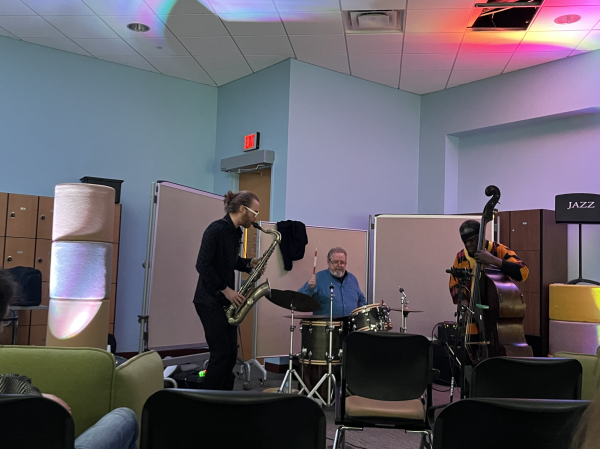Beyond the Beat: Exploration in Music and Culture
On Feb. 24, the Longyear Gallery in Alumni Hall opened “Beyond the Beat,” an international music and culture exhibition that, according to the exhibit, was organized, curated, and assembled almost entirely by nine students enrolled in the Fall semester’s Museum Curating class: MUSE 300.
“Beyond the Beat” displays culturally important pieces of music from various regions of the world and explains their significance. Most pieces originated from countries in Africa with a palpable aim to represent cultures underrepresented in contemporary museums. In addition to the various instruments assembled, the exhibit also presents statues and a painting with musical and cultural significance. All of the pieces aside from those contributed by students are part of the collection of Colgate’s Longyear Museum of Anthropology. In addition, a television on the wall plays recordings of musicians whom the students interviewed, explaining the exhibit’s significance.
Following the exhibition opening, there was a performance at 7:30 p.m. the same day at Memorial Chapel titled “Balla Kouyaté and World Vision Concert.” Kouyaté and his ensemble showcased music that was a spin on traditional West African music with hints of jazz and Afropop. The performance was meant to highlight the continuing vibrancy and relevance of African music in combination with the exhibition opening. Those that missed the live performance can find a recording on YouTube.
Rebecca Mendelson — co-director of University Museums, curator of the Longyear Museum of Anthropology and research affiliate and instructor in sociology and anthropology — taught the MUSE 300 class and oversaw the project.
“[My favorite part was] working with the students and watching their ideas evolve through time … If ‘the beat’ represents music, then ‘beyond’ incorporates all the cultural contexts in which music lives and thrives,” Mendelsohn.
She further explained that each section of the exhibition represents a “snapshot about music” and that students worked individually or in pairs to curate and design the exhibit based on their research and personal interests; she detailed that it was a collaborative process that required a lot of ingenuity and initiative on the part of each student to interview musicians and research “beyond” their pieces. In addition, she credited the title, “Beyond the Beat,” to one of her students, junior Jordan Nichols.
Mary Kate Doyle, a first-year who works with the museum, said, “Beyond the Beat is an exhibition about celebration and culture in relation to music and dance. The exhibition calls on its audience to reflect on how performance and music have impacted their own lives. For me, I’ve danced for 16 years and this exhibition reminds me of my self-expression through my art.”
Grace Dow, another first-year, said, “One particular display case that caught my attention was the panpipes and flutes. I was surprised to see that they had all been crafted in the late 1960s. In my mind, the date should have been much earlier because they look old. I left the museum curious about why this is the case.”
This exhibition appears to encourage individuals to think beyond the music and into the process of crafting the instruments and their cultural significance while also celebrating cultures that may not be familiar to many students. At the entrance to the exhibit, a signpost exclaims the museum’s commitment to considering “the legacies of violence, displacement, migration, and settlement that bring us together today” and commitment to building the relationship with the Oneida people and other Native American Tribes. “Beyond the Beat” seems to resonate with those values and emphasizes an academic approach that appreciates foreign cultures and celebrates musical passion at Colgate.

Robert "Jerry" Pfeifer is a junior from New Paltz, NY concentrating in political science. He has previously served as a staff writer for the Arts &...






